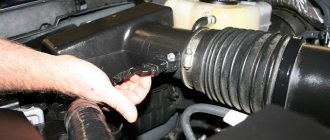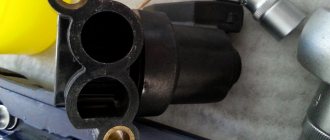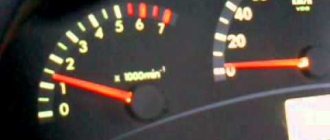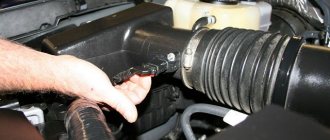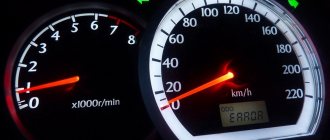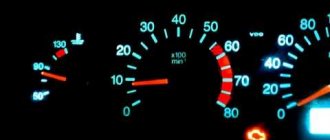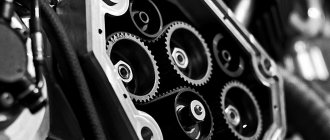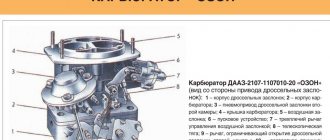Drivers often wonder why the engine speed does not drop at idle. This situation occurs quite often, and neither carburetor engines nor more modern injectors are immune from this. True, the reasons for the malfunction will be different. But, in practice, everything can be diagnosed independently, and on almost all car models the problem can be fixed with your own hands without much difficulty. The most important thing here is to make a correct diagnosis; this will significantly speed up the repair process and save you from additional problems and difficulties.
What it is?
Why doesn't the engine speed drop at idle?
First, let's decide how to understand that a problem has arisen, and also see what it can lead to. Even an inexperienced car enthusiast can detect an increase in idle speed. This is easy to hear. As the speed increases, there is an increase in the noise of the running engine when the gas pedal is released. Also, on cars equipped with a tachometer, you can track the increase in revolutions on the device. On almost all models of passenger cars, idle speed fluctuates between 650-950 rpm (check the indicator in the technical passport of your car), anything higher is considered a deviation from the norm. Also, on many injectors, this problem causes the “check” to turn on on the panel.
In any case, you should try to fix the problem as soon as possible. Increased speed is the reason for increased fuel consumption. This increases refueling costs. Also, an increase in speed significantly accelerates engine wear. So it is not advisable to delay solving this problem. This way you will significantly save your financial resources. When identifying and eliminating the cause of high speeds, you should remember that on carburetors and injectors the problem can be caused by various malfunctions.
Carburetors
First, let's deal with the problem on carburetor engines. This type of power supply is considered outdated, but many cars on the road are still equipped this way. Also, many car enthusiasts, for their own ideological reasons, use such engines, and are not going to give them up. Diagnosing the source of the problem here is quite difficult, and this is taking into account the small list of elements that cause an increase in speed. Let's look at what you should pay attention to:
- Needle valve position. In this case, the fuel does not flow into the chamber. Moreover, depending on the location in which the valve is jammed, idle speed can either disappear or, on the contrary, increase;
- Improper adjustment of the idle air system. This usually happens after cleaning or repairing the carburetor. To avoid problems, the fuel to air supply ratio should be set correctly. If you have not produced it before, then it is better to read how this is done specifically in your version;
- Closing problem. There may be several reasons for such a malfunction. Most often, it does not close due to the presence of carbon deposits on it. In this case, you will need to clean this node. Usually this helps. In some cases, the throttle valve may be damaged. Then you will need to change this part, but not all carburetors provide this option;
- Sometimes, the problem may occur when, this happens quite rarely. But it's still better to check. To do this, open the radiator cap with the engine running; if the gasket is burnt out, white smoke will come out of the neck. In this case, you will need to change the gasket;
- Open suction. Check how the damper in the primary chamber works. If you have identified a problem, then it makes sense to look at how the suction works. Most often, to fix the problem, it is enough to simply lubricate the cable and the damper drive.
Owners of front-wheel drive VAZs have enough troubles throughout the entire operation of the car. One of the most annoying is high idle speeds, moreover, on an already warmed-up car. This problem usually causes annoyance because there are too many reasons for its occurrence, and finding them is not easy.
Let's list them.
- The most basic is a malfunction or failure of the mass air flow sensor.
- No less common is the breakdown of the idle air control valve.
- A crankshaft position sensor providing incorrect information to the control unit can also be the root cause of a high or floating idle.
- The throttle position sensor may also be to blame.
- It happens that for some reason the gas pedal does not return all the way back. Moreover, this happens both because of a banal malfunction of the cable, and because of something completely ridiculous - for example, after washing the car, they covered the driver’s mat in such a way that the tip of the mat began to touch the pedal.
- The air filter is very clogged. Because of this, the combustion mixture is too rich in gasoline, again resulting in high idle speeds.
- The cable came off the throttle valve.
- Engine temperature sensor faulty. It gives the car’s “brains” incorrect values, which increase the crankshaft speed, thinking that the engine is cold.
As you can see, we have before us a whole forest of very different reasons why high revs appear! Next, we will take a closer look at the most typical, plus the most common problems associated with the problem described. At the same time, we’ll figure out how to eliminate them with our own hands.
Ways to eliminate the “sore”
If such a problem occurs, you need to look for which node is to blame analytically, checking all the specified sensors.
First, let's consider the following option for correcting the problem situation. Let's assume that a VAZ 2110 has high revs. An examination of the suspected components for faulty components showed that the throttle position sensor has traces of rust. It is located directly above the throttle valve. Measurements with a voltmeter showed that when the engine is idling, the voltage on it remains high - which means it does not close the damper.
How to fix the problem? For this we only need a screwdriver. Let's begin the procedure.
- By disconnecting the terminal block and also unscrewing two screws, we dismantle the assembly.
- We notice that traces of rust inside interfere with the movement of the wheel that regulates the position of the damper.
- We fill the insides of the defective device with a penetrating anti-rust aerosol.
- Use a development screwdriver to turn the wheel.
- We reassemble in reverse order.
Check to see if the engine idle speed is now high. The problem should go away.
Now let's look at another case. Let's say we have high idle speed in a VAZ 2114. This is what we do when faced with this situation.
When clarifying the circumstances of the problem under investigation, we always initially check the operation of the idle speed sensor. This device consists of a needle built inside an electromagnetic coil.
The needle either moves inside the coil, moving away from the hole in the throttle pipe, or moves out, closing this hole, thereby stopping the supply of air for combustion of the mixture.
Also read about and. This element is located at the throttle valve, opposite the gas pedal cable. To diagnose it, we pull out the terminal block from it, start the car, after which we see that we still have high engine speeds that have not changed at idle. Then we remove this defective unit, then clean it or replace it. For work we take:
- screwdriver;
- toothbrush;
- petrol.
Begin.
- Unscrew the two screws. We take out the broken node.
- We connect the wiring to it. Turn on the ignition. If the needle of the device moves slightly inside the coil to the touch, then it is working.
- If the needle does not react when an electric current is applied, wash the device with a toothbrush using gasoline.
- We do the assembly in reverse order.
When you cannot restore the functionality of this unit with your own hands, it is better to purchase a new one. Moreover, the cost of spare parts is low.
Other fixes
Of course, the options considered do not exhaust the possible ways to correct the shortcoming when high speeds are noticed precisely on a warm engine. To further study the most common situations, let's look at the case of a malfunctioning mass air flow sensor. This device is responsible for supplying the correct portions of air for combustion of the mixture, and also provides data to the electronic control unit about these portions, so that the unit proportions the supplied portions of gasoline.
This node can be diagnosed as follows. It is necessary to disconnect the terminal block from our mass flow regulator, and then start the engine, after which it is necessary to drive the crankshaft speed above 2000 rpm.
In this case, the emergency mode is automatically launched, portions of the mixture are now calculated only by the position of the damper. If the sensations show that the car with the disconnected sensor has become more dynamic than with the connected one, then the malfunction of this unit is obvious.
To replace it, take the following tools:
- Phillips screwdriver;
- flat screwdriver.
We are starting renovations.
- After turning off the engine, disconnect the wires from the mass air flow sensor.
- Loosen the clamp and remove the hose on the inlet pipe.
- We dismantle the defective device by unscrewing two bolts.
- We are replacing the device.
- We do the assembly, moving backwards point by point.
This is how this cause of high revs is eliminated.
For some reason it didn't help
Now let's look at another situation. The car owner changed, for example, the idle speed sensor, and the crankshaft speed became high, or remained high as before.
The reasons for this unpleasant phenomenon may be as follows.
- Most likely, the car enthusiast made the replacement just like that, at random, maybe it would stop turning too quickly. The real state of affairs suggests that the fault needs to be looked for elsewhere.
- If this sensor is not a completely new model, it has an adjusting bolt, it may need to be tightened in order to adjust the problem unit. Modern idle air valves do not require any additional adjustment when installed. However, for example, if the Priora has high idle speeds, then you can look for the adjusting screw on this car.
- It is possible that the new spare part was defective.
- The new spare part was installed incorrectly.
Here, perhaps, all the roots of the phenomenon are listed.
Let's talk about cost
Not everyone can afford this type of repair, such as even reinstalling a sensor. Although the main difficulties are caused not so much by replacing one of the sensors involved in the process, but by diagnosing the sources of overestimation of the crankshaft speed when idling. After all, we have found that the search for the causes of this disease is complicated by their diversity.
If a car enthusiast decides to contact a service station with a request to find the cause of high engine speeds at idle, then the cost of diagnostics in major cities of the Russian Federation will be as follows.
| City | Price |
| Moscow | 700 rub. |
| St. Petersburg | 650 rub. |
| Ekaterinburg | 500 rub. |
| Samara | 500 rub. |
| Krasnodar | 550 rub. |
Since the cost of manipulation is low, if a car owner doubts the success of a manual diagnosis, he can safely contact a service station.
Throughout the article, we looked at the main options for solving a common problem. Now, if a car enthusiast encounters an increase in idle crankshaft speed, he will already know what to do.
Now read about and.
Many owners of injection cars could observe the effects when the speed suddenly drops at idle. This phenomenon occurs especially often when the engine is warmed up to operating temperatures. Sometimes the revs drop so low that the engine stalls. Let's figure out what can cause low idle speeds on a warm engine, and also find out why they drop. This information will be useful to everyone.
The origins of unstable engine operation at XX
How will the picture develop if the control unit does not receive data on the quantity and volume of air consumed? So, for example, the reaction of the throttle sensor will be as follows - the speed will initially increase, but then the fuel mixture will begin to become leaner, as a result of which low speeds will be established on a hot engine. There is only one reason for this - the amount of air consumed by the engine has decreased.
However, the opposite happens - the fuel mixture becomes richer, and the engine begins to gain speed again. Such cycles can alternate endlessly; these are floating revolutions. The problem of low idle speed on a warm engine in winter is especially pressing.
On some cars, events may develop differently - the speed increases, for example, to 2000 rpm, and remains there. The reason is that the injector injects increased amounts of fuel. The amount of air does not increase, otherwise the engine would be able to increase the speed to 3 thousand, however, then it would still start to stall.
Choosing an auto electrician - main features
Most problems with increased speed, increased fuel consumption, and unstable idling are solved by an electrician. This specialist finds problems in the electrical part of the car, diagnoses all components, and carries out repair work in the electrical part. You are unlikely to figure this out on your own; you will have to try hard to study the wiring diagram for all the parts of your car. And finding the location of all the sensors is often difficult, especially in a technologically complex modern car. So you need to entrust the work to an experienced craftsman.
When choosing an auto electrician, consider the following features:
- official service - in most cases this will be the best solution, since here specialists work only with one specific brand of car and provide a guarantee of quality;
- the equipment of the service station plays an important role in identifying potential problems in your car; you just need to make sure that the station is well equipped and has normal equipment;
- experience of a specialist - pay attention to who exactly will service your car, the technician must be quite experienced, it is better to check reviews about him from different sources;
- a good option is to choose an electrician by recommendation; if you do not use the services of an official station, the recommendations of your friends will help you find the optimal service;
- It is worth starting cooperation with diagnostic services; diagnostics will show how competent the specialist is and whether there is any point in further cooperation with these specialists.
As you can see, there are several ways to check a person’s competence and make sure of his professionalism. If you decide to have your car serviced at an unverified station, be sure to be present during the repair and monitor every step of the technician. This is your right, it is quite possible to be present during repairs even in a garage station, where not a single master will like it. You can leave your car unattended either with the officials or with a trusted service that you have been working with for quite a long time. Keep this in mind the next time you need to go get your car repaired.
We also suggest watching a video about car diagnostics:
Possible reasons
So, what causes this problem? Some of the most vulnerable links in injection engines are sensors. One of the elements that directly affects engine performance and quality is the idle speed sensor. You can often find it near the throttle valve. This is a stepper motor with a tapered locking needle. When the throttle is closed, air bypasses the damper through the idle channel, which is blocked by the needle.
Another culprit for very low idle speed is Air - the second important component for preparing the fuel mixture after gasoline. Therefore, if the mixture is lean enough, then high speeds will not come from anywhere.
When malfunctions occur in the system, the ECU cannot correctly select and calculate the proportions of the fuel mixture in idle mode. As a result, the engine operation will be unstable, the speed will begin to fall and rise.
A less common problem with low idle speeds on a warm engine can be improper operation of the EGR system, or more precisely its valve. The element is installed in the intake manifold and its function is to remove exhaust gases. This is nothing more than Periodically the sensor needs to be cleaned.
It would also be a good idea to make sure that there is no air leak in the system and check the condition of the throttle valve. Often the problem of low speeds can be associated with a dirty valve or its mechanical damage or deformation. It often happens that for one reason or another the valve jams - hence another reason for low speeds.
Engine speed does not drop: why does this happen?
For normal engine operation and acceptable fuel consumption, it is necessary that all power unit systems operate properly. In this case, the engine should operate normally both under load and in idle mode.
In this article we will talk about why engine speed does not drop, and also consider the main reasons why such problems arise on carburetor and injection cars.
Why do sensors die?
Experts identify two reasons for low idle speed. One of them is related to low fuel quality. Often, a low octane number not only greatly contaminates the working surface of the sensor, but can also cause various malfunctions in the operation of electronic units.
In addition, sensors often fail due to banal defects or exceeding their service life. Inexpensive sensors may well turn out to be of low quality or defective. This is why low idle speeds appear on cars.
How to clean the idle air control (IAC)?
When there is a problem with low idle speed on a warm engine, in some cases it can be eliminated by flushing the IAC. To do this, de-energize the car. The regulator is located on the throttle assembly, below the TPS (throttle position sensor). You should prepare a clean rag, a screwdriver, liquid in an aerosol can - this can be any product for cleaning carburetors or injectors.
Cleaning begins with dismantling - to remove it, just unscrew the mounting screws. Sometimes there are also bolts. Once the sensor has been removed from its mounting location, the cleaning process can begin. The work is carried out using rags treated with liquid from a spray can.
It is also necessary to spray the needle from the can. The latter on various car models can be either metal or plastic. The cleaner will not damage the plastic. But the liquid should not get under the spring. If this does happen, it is recommended to blow out the sensor with compressed air as quickly as possible. If this is not done, the liquid will wash out the internal lubricant, which will cause complete failure of the IAC.
Higher revs: sensors also matter
The tone of operation of the mechanical throttle valve is directly determined by two regulators: TPS and IAC (throttle position sensor and idle speed control, respectively). There are a couple of other sensors that can affect throttling - these are the mass air flow sensor and the air flow sensor (mass air flow sensor and coolant temperature sensor).
If the TPS is faulty, all sorts of deviations from the norm are observed. The engine may either stall at idle or pick up speed. In principle, the same picture is observed during the operation of a defective IAC. Uncontrolled air leaks at the inlet, just like a failed mass air flow sensor, lead to an increase in speed or to a floating idle.
A slightly different reaction is observed with defective DTOZH. The computer perceives a heated engine as cold, sending the IAC command to open the throttle slightly and continue to hold the same 1,500 rpm.
When releasing the gas, the speed is increased or “freezes”: common malfunctions
Let's start with the fact that on many cars with an injector, the speed rises during warming up. This is necessary to ensure that the power unit operates stably after a cold start.
However, after the temperature rises, the control unit reduces the idle speed, bringing it to normal. On many cars with a carburetor, the driver independently increases the speed during warm-up, using the so-called “choke”.
Moreover, after the engine is warmed up, the normal idle speed is, on average, 650-950 rpm. If you press the gas and release the accelerator, the speed should increase, and then decrease again to the specified values.
Also, a situation often arises when the speed drops slowly or is constantly kept at around 1.5 thousand rpm, 2 thousand revolutions, etc. Naturally, in such cases, consumption increases and the internal combustion engine wears out more, which indicates the need for diagnostics.
- So, let's start with common carburetor problems. Often the engine speed does not drop due to problems with the throttle valve. For example, when the driver steps on the gas, the throttle must be opened wider to allow more air to enter the cylinders to burn fuel. After the gas pedal is released, the throttle closes and the speed decreases.
If the damper does not close completely, an over-enriched mixture enters the cylinders, and the speed is increased. The cause may be severe contamination of the throttle assembly or damage to the valve itself (deformation). First you need to clean the damper; carburetor cleaning liquid is suitable as a cleaner.
We also note that the damper does not close tightly even when the drive cable is worn out. In this case, the cable must be replaced. On carburetor cars, engine speed often does not drop even if the gasket between the carburetor has failed. The culprit may also be an intake manifold that is damaged.
The main task is to find the correct ratio of fuel and air. Often, a high level of fuel in the carburetor float chamber also leads to increased speed. The check should begin with the needle valve.
- Now let's move on to the injector. Please note that on many injection cars. As for problems, the injection system itself is more complex, that is, there are more reasons for high speeds compared to the carburetor.
As a rule, problems with speed can be caused by problems with both mechanical elements and electronic components. In the list of main malfunctions, experts highlight malfunctions of the coolant temperature sensor, which is installed in.
In simple words, if the specified sensor gives an incorrect signal, the ECU considers that the engine is cold and activates the warm-up mode. In this case, the control unit raises the speed so that the power unit operates stably and reaches operating temperature faster.
Also, problems with speed can begin due to malfunctions and malfunctions (idle speed regulator). It also happens that the throttle cable gets stuck and becomes wedged. The spring that closes the throttle valve may also become stretched or damaged.
Special attention should be paid to gaskets, since air leaks can lead to disruption of mixture formation. This means that you need to separately inspect manifold gaskets, injector seals, etc.
How to find and fix problems with high speed?
If you have a modern, high-quality car, just go to the service station. It is better to use the services of an official service if your car is under warranty. This way you will maintain the warranty and be able to find specific problems with branded equipment. Finding a problem should start with diagnostics. On injection engines it is possible to use special computer diagnostic systems. You can use even a simple sensor like the ELM-327 and look for problems in the system yourself.
The algorithm for solving the problem is as follows:
- you go to a mechanic and carry out computer diagnostics of the car, at this stage most of the sensors are checked for errors and incorrect information, and the ECU is tested;
- if the problem is not found, it is worth paying more attention to testing the idle air regulator or the sensor on the damper; this unit does not always produce errors during computer diagnostics;
- if everything is fine with this unit, it’s worth looking at whether there are problems in the wiring; usually an electrician will help do this; high-quality diagnostics will be the starting point in solving the problem;
- further, the problems found must be eliminated; to do this, choose high-quality original spare parts; installing cheap Chinese sensors will not lead to the desired result;
- The last stage of repair is a thorough re-diagnosis to determine the condition of all components, as well as to prove the absence of problems, this is an important final stage.
After this, you need to check the operation of the car in all modes. If everything is done correctly and efficiently, there will be no problems with the car. It is worth considering that diagnosing the electrical part is often a complex process. Each sensor requires a special approach. Sometimes you have to measure the voltage or resistance at the sensor contacts with a multimeter in different modes and operating conditions. All this delays the process of detecting a breakdown. But you definitely need to deal with the problem, if there is one. Otherwise, the engine will continue to operate in uncomfortable modes and will wear out faster.
Floating speed: reasons
Note that in some cases the revolutions do not just slowly fall or remain at the same level, but “float”. In this case, the engine may become unstable. first they fall, then they increase sharply and everything repeats. A common cause of this phenomenon is the supply of excess air, which leads to “jumps” in speed at idle.
Such problems arise if the air supply sensor () fails, which allows the ECU to calculate how much air is supplied and how much fuel is supplied to prepare the required mixture.
If malfunctions occur, the control unit cannot prepare the “correct” mixture for the idle mode, which causes speed jumps after releasing the gas pedal or when the engine is idling.
Lada Priora slows down poorly
The VAZ Priora (2170) slows down its speed poorly.
Hi all. On my Priore, the speed does not drop when switching and can even rise on its own and hold on for a long time, 10 seconds or more. If you gas, it throws off. I cleaned the throttle - didn't help, changed the IAC - didn't help, changed the throttle valve regulator didn't help either. I tried to remove the chip from the air flow and start it, but the revolutions did not rise to 1600 as in theory they should. I sit and think what else could happen. @andrienko.1966 —> My momentum isn’t slowing down either, but it’s also picking up. I tried re-gasping, but it doesn't help. All this happens at idle! Sometimes the speed jumps when the engine is warm. What could it be?
@andrienko.1966 —> On front-wheel drive vehicles this eliminates skidding.
At idle there is no charging, when the speed increases to 3 thousand, charging appears, then at idle it is there. Cause.
Recently the following problem has appeared. While driving, pressing the clutch pedal (to change speed or when braking) turns off the engine in the instrument panel.
Priora 16 class. What could be causing this? After starting the engine cold, the engine runs unevenly, the speed is uneven, all 4 cylinders work at the same time. The check does not light up. After m.
As long as the engine is not warmed up while driving, everything is fine. After warming up to 90 degrees, when overtaking, when you sharply press the gas pedal, it begins to twitch. You release the pedal a little.
I suffered for 3 months with the same problem - on a warm engine the revolutions increased to 2000 and held for 5-10 seconds, tinkered with the guys, changed the throttle, IAC, temperature sensors, changed spark plugs, tinkered with the ignition - it didn’t help, I went to the service center a couple of times but since the “check” did not light up, there are no errors and even if it cracks. And then the other day I went to check the fluid level in the power steering barrel, everything was ok there, my gaze fell on the intake manifold on which some kind of lump was hanging on the back side (from the cabin side). I look exactly at the place where the hoses are placed under the air conditioner and there are plugs. One itself fell off somewhere and there were scraps left, the second stood in place, but I took it off - it was oak and burst along the length. I changed it while the engine was running - the increase in speed stopped, but it stopped starting. After that, I took them off, started them, and it floats. I removed the battery terminals for about 3 hours, installed the plugs, connected the terminals, everything worked and no longer floats!
Source
Let's sum it up
As you can see, in order to accurately determine why the engine speed is not reset, in many cases in-depth diagnostics may be necessary. For carburetor engines, it is often necessary to clean and adjust the carburetor itself, while the injector will require.
If the problem is not on the surface (the throttle cable has become sour, after washing or dry cleaning, the carpet in the cabin is not installed correctly, which presses the gas pedal, etc.), then it is better to take the car to a service center.
The most complex situation is one when it involves the presence of a large number of sensors and actuators. In this case, even the use of diagnostic equipment does not always allow you to quickly and accurately determine the problem.
If diagnostics are difficult, it is optimal to deliver the car to a service that specializes in repairing a specific brand of car. As a rule, these are official dealer service stations; it is less common to find third-party organizations.
Finally, we note that timely detection of a problem allows you to save other components and assemblies. In other words, high idle speeds, floating speeds and jumps indicate that there are problems with the air/fuel supply or with mixture formation. Ignoring such problems negatively affects the engine and its service life.
Problems with the carburetor system
When releasing gas, the drop in speed can be bad for both injectors and carburetor systems.
If the car has a carburetor, then there may be several defects.
Most often, the speed does not drop due to a faulty throttle valve. When the engine warms up, it is in the open position to allow more air into the system. Then it closes and the speed should drop.
If the throttle valve is not closed completely, the mixture will still be over-rich when the operating temperature is reached, and the speed will remain at the same level. If this part is heavily soiled or deformed, it cannot close completely.
You can clean the damper using a special product, which can be purchased at an automotive supply store. Deformation may require replacing the carburetor completely. The damper may not close tightly if the drive cable is severely worn. Replacing it may improve the situation.
Another common reason why the engine speed does not drop when idling is the gasket between the carburetor and the cylinder head, which has become unusable, or a damaged intake manifold.
After replacing the carburetor or cleaning the power system, you can often notice that the engine speed is slowly dropping. This occurs due to improper adjustment of the idle system; an over-enriched air-fuel mixture is often supplied. To eliminate the malfunction, it is necessary to adjust the ratio of fuel and air supply to the system.
A high level of fuel in the carburetor float chamber can also cause a malfunction. The needle valve is responsible for it. Checking this detail may correct the situation.
How to determine if there is a problem
First you need to understand how you can independently determine increased or simply abnormally high speeds in your own car. After all, even at idle there is a certain level of speed and it must be stably maintained.
In practice, identifying a problem that suddenly appears is quite simple. Even in situations where a novice is driving, and he does not have much experience in such matters. The first thing you can do is simply listen to the operation of the internal combustion engine. The lower the engine speed, the quieter it will ultimately operate. But it’s even easier to diagnose a problem using a tachometer, which is installed on the vast majority of cars and trucks. Look at the position of the arrow and record exactly what revolutions you see when driving at a measured, calm pace, and what the device shows after warming up or when releasing the gas.
Depending on the engine, each power unit has its own idle speed limits. Usually this is from 650 to 950 rotations per minute.
Now take a look at the instruction manual. The normal parameters for XX must be indicated there. If the current values differ from the values from the manual, this can be considered a deviation. That is, you need to start searching for the provoking factor.
Owners of injection engines are greatly helped by on-board electronics. If the speed at idle is higher than the standard set by the manufacturer, the check engine light will probably light up on the dashboard. Here I advise you to take a look at our material, where we talked about dashboard icons and their meaning.
Injector system
If your car has an injection system, there may be many more reasons for high idle speeds. Here, both mechanical elements and electronic devices responsible for adjusting the idle speed can fail.
The main injector malfunctions include:
- Incorrect operation of the temperature sensor installed in the cooling system. Incorrectly received data from this device causes the electronics to recognize the engine as cold and work to warm it up, thereby maintaining high speeds necessary to reach operating temperature. Overheating can often occur, which leads to more serious damage, including major engine repairs. The same effect is possible if the idle speed control is not operating correctly.
- The throttle control cable may become stuck. The higher the mileage of the car, the higher the risk of encountering a similar problem.
- The electronic XX operation sensor often malfunctions, then the speed will either increase or disappear altogether.
- The spring that brings the throttle valve to its original closed position is not functioning properly, is jumping off, or is being stretched too far.
- Too much air enters the fuel combustion chamber due to poor quality or leaky gaskets. It is necessary to carefully check the seals of the manifold and injectors.
- And the simplest reason is usually the incorrect placement of the mat after a visit to a car wash or dry cleaning of the interior. It is often inaccurately placed under the accelerator pedal, which leads to the appearance of improper engine operation.
If the car is oversaturated with various electronics and all the work is based on the correct functioning of the sensors, one of them may well become a problem. It will supply incorrect data to the computer, and as a result, the speed will not drop. You will most likely not be able to detect the problem on your own.
It is necessary to contact a car service for computer diagnostics. The task is best handled by specialists working at a service center that specializes in repairing a specific brand of car. If the diagnosis is carried out on time, then it is quite possible to get away with simply replacing the sensor.
You shouldn’t delay repairs, because a supersaturated mixture has a bad effect on engine performance and significantly shortens its service life.
Possible consequences
Similar phenomena occur on a large number of machines. Almost any modern and fairly old motor can present its owner with such a surprise. It could be:
- VAZ 2109;
- Renault Logan 1.4;
- VAZ 2107;
- VAZ 2110;
- Chevrolet Sens;
- Mitsubishi Lancer 9;
- Niva Chevrolet;
- VAZ 2114;
- Kia Cherato;
- Chevrolet Lacetti;
- Chevrolet Lanos;
- Toyota Corolla, etc.
It would seem that the speed has increased, but nothing terrible is happening.
In fact, processes can occur in the engine that are initially invisible to the driver. But gradually the consequences will become obvious and often frightening in their cost of recovery.
Under no circumstances should you allow the revs to increase while idling.
This can be explained by several main possible consequences.
Here we are talking about the following potential problems:
- Fuel consumption will constantly increase, which will negatively affect your budget;
- A hot engine leads to problems with the cooling system and a general reduction in service life;
- Often fuel will simply fly away into the pipe, which also threatens its detonation in the exhaust system;
- The total resource of the power unit will begin to decrease;
- The node associated with the increase in speed will suffer.
There are quite a lot of reasons for promptly taking action and eliminating the provoking factor.
Floating speed
In addition to slowly falling revs, car enthusiasts may encounter a phenomenon called floating revs, when they drop and then rise sharply. The reason is excessive air supply into the system, which causes the engine to spin up to 2 thousand revolutions at idle.
This often happens in cars that have a fuel injection sensor. It calculates how much air the mixture needs. When its operation is disrupted, different amounts of oxygen are supplied at different times, as a result, speed jumps are observed approximately every 3 seconds.
Faced with a similar phenomenon, the same computer diagnostics will be a prerequisite. It is very important that this and all subsequent work is carried out by experienced, qualified specialists. By contacting a service that does not specialize in breakdowns of this kind, you may be faced with the need to carry out an expensive overhaul of the engine ahead of time.
Conclusion
If your car has floating idle speed, you must:
- Remember if you have recently refueled at low-quality gas stations.
- Check the system for air leaks.
- Check all sensors that are involved in the formation of the fuel mixture.
- Check the fuel pressure in the system.
All these tips will help you independently find the cause of a breakdown in your car and fix it without much expense.
Source
